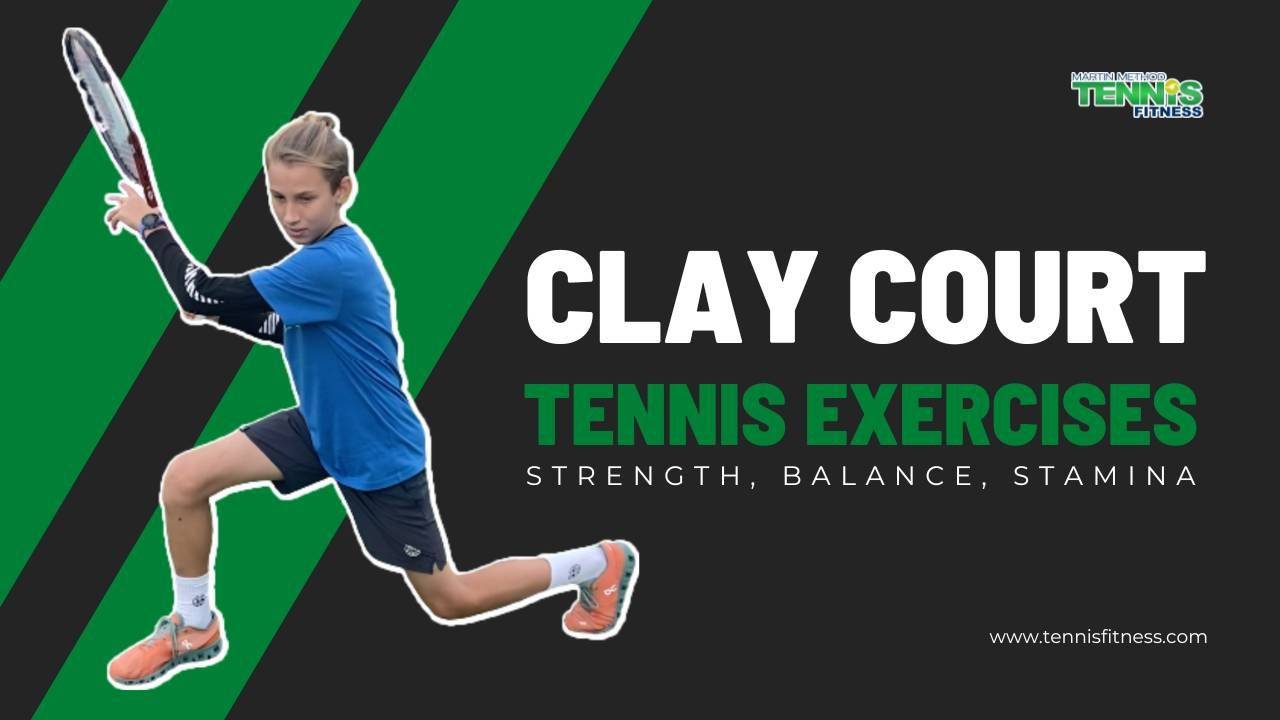Clay Court Tennis Exercises
May 08, 2023
The best way to prepare for any surface is to hit on it and do your tennis training on it as much as possible. The law of adaptation teaches us that when we are exposed to certain stimuli repeatedly with enough time to recover; physically, technically, and mentally we will adapt.
Without enough exposure, not much will change. This especially applies to clay-court tennis. By far the toughest surface to deal with. You need to learn how to slide into shots on clay, recover after hitting, and stay balanced. When you are born in a country where the main surface you train and compete on is clay, it just becomes natural to move efficiently, you don’t even realize it happens.
You can start sliding when you build up that confidence. In fact, some pro players I have worked with that grew up playing on clay, mentioned they never learned how to slide on clay, they all said they just did it.
The other requirements needed to move well on clay are good balance, a low center of gravity, and most importantly, strength in your legs. For better balance and control, it's critical to have a good low stance, keeping yourself balanced, and being aware of the first step movement. 
Clay Court Tennis Training Tips for you to consider:
- You need to slide and hit – not hit and slide.
- For good body control, you need to have good strength in the core, hips, and especially in the adductors. Check out a tennis training program here.
- You need good timing, which comes with practice.
- For stability, you need to have a low center of gravity and a wide base.
- Because of the inconsistent bounce/ surface, you will be hitting the ball higher, so you need good shoulder stability. Young players who need help with their tennis strength development go here.
- You need to have a good reaction, as the lines are plastic, so the balls can shoot through on you.
- Clay means there’ll be more topspin, as the grit from the court allows more bite. Slower ball, higher bouncing ball.
- Clay is generally a slower surface with more topspin, so it's harder to hit winners. Be prepared to get into a battle at each point.
- You need to learn to be more patient.
- On clay, there is less traction underfoot, so you need to build confidence. Doing agility drills on clay will help build confidence.
- The points tend to be longer, so it’s important to have good power endurance, and stamina.
Specific Clay Court Tennis Exercises
Here are some tennis exercises that will help you improve your clay-court game. Check out the video above.
1. Slide Swing - This is a great way to develop strength and stability through sliding movement. Concentrate on staying centered and balanced. At the end range add the racket swing in, this is a good way to teach yourself how to slide and hit.
2. Push up Rotation. One of my favorite upper body tennis exercises. Due to the fact on clay, you will be hitting more shots, you need to develop more strength and stability through the shoulders and chest, plus work on rotational control and core stability. This exercise needs to be done with slow controlled movement, focusing on the connection between the moving body parts and the muscles supporting the stable shoulder joint.
3. Banded Open Stance Rotation. This exercise will help develop balance through a rotational plane. If you want to get good at sliding and hitting as well as just hitting on clay you need to have good balance through rotational movement. Brace through the core as you rotate the torso, keep the legs stable by feeling firm connect with the ground.
4. Dumbbell Side Lunge. This exercise is the best way to strengthen your legs for clay-court tennis. Due to the fact you open up and stretch the inside of the thigh (adductors) and load the opposite hip (like in sliding), makes this exercise a great way to work on strengthening up the specific muscles needed to help you get around on clay.
5. Band High Flye. We know we are dealing with high bouncing balls when playing on clay. That often means hitting balls at a higher contact point. If the shoulder girdle is not prepared for this, players will lose power and, more importantly, be more susceptible to injury. This exercise is a good way to strengthen the posterior shoulder muscles in a higher range.
6. Side Hop Swing. Creating balance on clay starts with having good lower-body dynamic stability. Sliding, stopping, and accelerating all rely on having ankle, knee, and hip stability. Working on this area helps players feel more balanced and controlled when hitting through shots on an unstable surface. This exercise challenges players to hop and balance on 1 leg, then swing through a shot maintaining control of their body.
7. Lunge Hold Swing. If you want to play well on clay you need to be able to last out a match. That means having enough muscle endurance to get you through. This specific exercise is aimed at challenging your lower body in short isometric bursts. By holding these isometric positions continuously we start to challenge the muscle through specific movements. This is how we help prepare the body and help it adapt to the rigors of clay-court tennis.
If you are someone who needs more guidance and support with their tennis training. We provide online tennis fitness programs for players of all ages and stages, check them out here.
So I have taught you some basics of what you need to work on to play better on clay. You have some tennis exercises and tennis tips to take away and apply. Now it is up to you to go and give it a go!
I hope you enjoyed this tennis blog, it is one of many we have written to help you as a player become better at what you do on the court.
We also offer full comprehensive personalized programming online. This is where you work in close contact with one of our tennis fitness coaches. This is the best way to fast-track your results, in fact, we get amazing results with players who do this.
Until next time keep working hard on your tennis fitness and be consistent!
>> Recent Blog: Tips for Tennis


